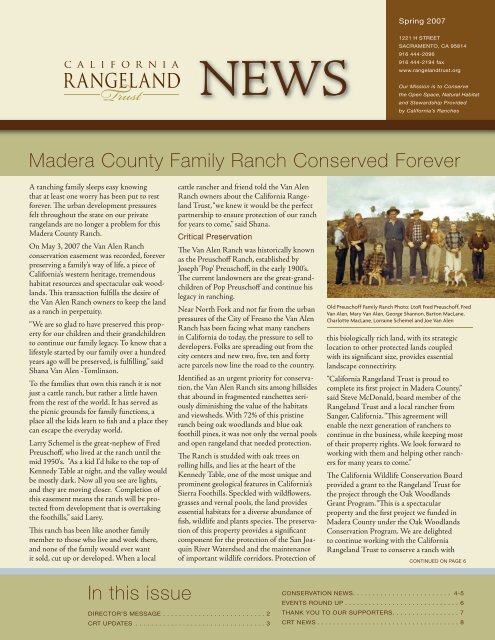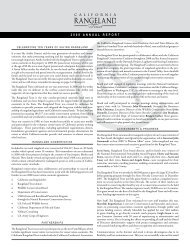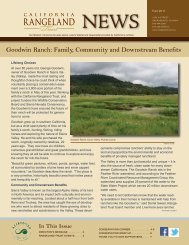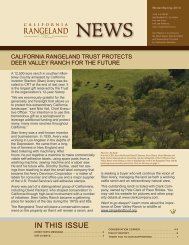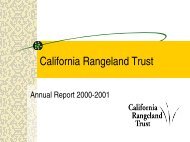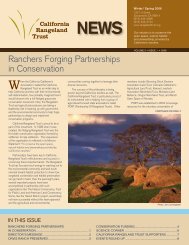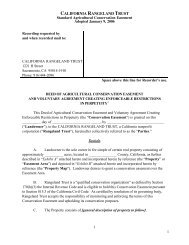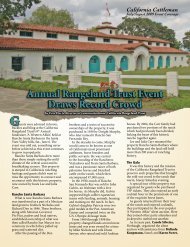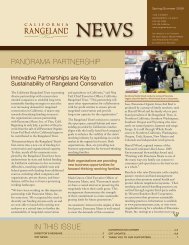Spring 2007 Newsletter - The California Rangeland Trust
Spring 2007 Newsletter - The California Rangeland Trust
Spring 2007 Newsletter - The California Rangeland Trust
Create successful ePaper yourself
Turn your PDF publications into a flip-book with our unique Google optimized e-Paper software.
<strong>Spring</strong> <strong>2007</strong><br />
1221 H STREET<br />
SACRAMENTO, CA 95814<br />
916 444-2096<br />
916 444-2194 fax<br />
www.rangelandtrust.org<br />
Our Mission is to Conserve<br />
the Open Space, Natural Habitat<br />
and Stewardship Provided<br />
by <strong>California</strong>’s Ranches<br />
Madera County Family Ranch Conserved Forever<br />
A ranching family sleeps easy knowing<br />
that at least one worry has been put to rest<br />
forever. <strong>The</strong> urban development pressures<br />
felt throughout the state on our private<br />
rangelands are no longer a problem for this<br />
Madera County Ranch.<br />
On May 3, <strong>2007</strong> the Van Alen Ranch<br />
conservation easement was recorded, forever<br />
preserving a family’s way of life, a piece of<br />
<strong>California</strong>’s western heritage, tremendous<br />
habitat resources and spectacular oak woodlands.<br />
This transaction fulfills the desire of<br />
the Van Alen Ranch owners to keep the land<br />
as a ranch in perpetuity.<br />
“We are so glad to have preserved this property<br />
for our children and their grandchildren<br />
to continue our family legacy. To know that a<br />
lifestyle started by our family over a hundred<br />
years ago will be preserved, is fulfilling,” said<br />
Shana Van Alen -Tomlinson.<br />
To the families that own this ranch it is not<br />
just a cattle ranch, but rather a little haven<br />
from the rest of the world. It has served as<br />
the picnic grounds for family functions, a<br />
place all the kids learn to fish and a place they<br />
can escape the everyday world.<br />
Larry Schemel is the great-nephew of Fred<br />
Preuschoff, who lived at the ranch until the<br />
mid 1950's. "As a kid I'd hike to the top of<br />
Kennedy Table at night, and the valley would<br />
be mostly dark. Now all you see are lights,<br />
and they are moving closer. Completion of<br />
this easement means the ranch will be protected<br />
from development that is overtaking<br />
the foothills,” said Larry.<br />
This ranch has been like another family<br />
member to those who live and work there,<br />
and none of the family would ever want<br />
it sold, cut up or developed. When a local<br />
cattle rancher and friend told the Van Alen<br />
Ranch owners about the <strong>California</strong> <strong>Rangeland</strong><br />
<strong>Trust</strong>, “we knew it would be the perfect<br />
partnership to ensure protection of our ranch<br />
for years to come,” said Shana.<br />
Critical Preservation<br />
<strong>The</strong> Van Alen Ranch was historically known<br />
as the Preuschoff Ranch, established by<br />
Joseph ‘Pop’ Preuschoff, in the early 1900’s.<br />
<strong>The</strong> current landowners are the great-grandchildren<br />
of Pop Preuschoff and continue his<br />
legacy in ranching.<br />
Near North Fork and not far from the urban<br />
pressures of the City of Fresno the Van Alen<br />
Ranch has been facing what many ranchers<br />
in <strong>California</strong> do today, the pressure to sell to<br />
developers. Folks are spreading out from the<br />
city centers and new two, five, ten and forty<br />
acre parcels now line the road to the country.<br />
Identified as an urgent priority for conservation,<br />
the Van Alen Ranch sits among hillsides<br />
that abound in fragmented ranchettes seriously<br />
diminishing the value of the habitats<br />
and viewsheds. With 72% of this pristine<br />
ranch being oak woodlands and blue oak<br />
foothill pines, it was not only the vernal pools<br />
and open rangeland that needed protection.<br />
<strong>The</strong> Ranch is studded with oak trees on<br />
rolling hills, and lies at the heart of the<br />
Kennedy Table, one of the most unique and<br />
prominent geological features in <strong>California</strong>’s<br />
Sierra Foothills. Speckled with wildflowers,<br />
grasses and vernal pools, the land provides<br />
essential habitats for a diverse abundance of<br />
fish, wildlife and plants species. <strong>The</strong> preservation<br />
of this property provides a significant<br />
component for the protection of the San Joaquin<br />
River Watershed and the maintenance<br />
of important wildlife corridors. Protection of<br />
Old Preuschoff Family Ranch Photo: LtoR Fred Preuschoff, Fred<br />
Van Alen, Mary Van Alen, George Shannon, Barton MacLane,<br />
Charlotte MacLane, Lorraine Schemel and Joe Van Alen<br />
this biologically rich land, with its strategic<br />
location to other protected lands coupled<br />
with its significant size, provides essential<br />
landscape connectivity.<br />
“<strong>California</strong> <strong>Rangeland</strong> <strong>Trust</strong> is proud to<br />
complete its first project in Madera County,”<br />
said Steve McDonald, board member of the<br />
<strong>Rangeland</strong> <strong>Trust</strong> and a local rancher from<br />
Sanger, <strong>California</strong>. “This agreement will<br />
enable the next generation of ranchers to<br />
continue in the business, while keeping most<br />
of their property rights. We look forward to<br />
working with them and helping other ranchers<br />
for many years to come.”<br />
<strong>The</strong> <strong>California</strong> Wildlife Conservation Board<br />
provided a grant to the <strong>Rangeland</strong> <strong>Trust</strong> for<br />
the project through the Oak Woodlands<br />
Grant Program. “This is a spectacular<br />
property and the first project we funded in<br />
Madera County under the Oak Woodlands<br />
Conservation Program. We are delighted<br />
to continue working with the <strong>California</strong><br />
<strong>Rangeland</strong> <strong>Trust</strong> to conserve a ranch with<br />
CONTINUED ON PAGE 6<br />
In this issue<br />
DIRECTOR’S MESSAGE . . . . . . . . . . . . . . . . . . . . . . . . . . 2<br />
CRT UPDATES . . . . . . . . . . . . . . . . . . . . . . . . . . . . . . . . . 3<br />
CONSERVATION NEWS . . . . . . . . . . . . . . . . . . . . . . . . . 4-5<br />
EVENTS ROUND UP . . . . . . . . . . . . . . . . . . . . . . . . . . . . . 6<br />
THANK YOU TO OUR SUPPORTERS . . . . . . . . . . . . . . . . . 7<br />
CRT NEWS . . . . . . . . . . . . . . . . . . . . . . . . . . . . . . . . . . . . 8
Director’s Message<br />
DIRECTOR’S MESSAGE<br />
BACK AT THE RANCH<br />
BY DARRELL WOOD. CHAIRMAN<br />
Our family started in the cattle business back in 1865 in Lassen<br />
County. We are still ranching here today and when I look out at<br />
the land my ancestors worked I see the influence of their management<br />
all around me. <strong>The</strong> best part of this is now my children can<br />
look around and see the same thing. My son Ramsey and daughter<br />
Dallice are 6th generation ranchers in this part of the county.<br />
Some things have changed here at the ranch since back then but<br />
many things remain the same. We run in similar country as we did<br />
in the mid 1800’s and we fortunately still own some of the same<br />
land. <strong>The</strong> differences now are that we ship cattle to annual grass<br />
country in the Sacramento Valley and therefore do not winter<br />
cattle up north anymore.<br />
In the past, genetics were not a factor that my ancestors looked at<br />
closely. <strong>The</strong>y typically looked for bulls that were nearby for ease<br />
of transportation or they would simply keep back the biggest bull<br />
calf and use him. Simply getting calves on the ground was the<br />
main objective.<br />
Our operation today is very focused on our genetic program and<br />
the careful selection of those animals that will meet our family’s<br />
and the consumer’s standards for quality. Currently we select bulls<br />
with higher than average scores in traits such as marbling, rib-eye<br />
size and early maturing cattle. With our grass-fed beef business we<br />
need to focus on the traits that will maximize our resources and<br />
the time it takes to finish cattle on a strictly grass based diet.<br />
I get a little teary eyed when I think about the first time each of<br />
my kids told me they wanted to come back to the ranch after<br />
college. Ramsey was a junior in college at Cal Poly in San Luis<br />
Obispo and he called and said he wanted to come home and be<br />
a partner in the family business. Dallice went to Chico State and<br />
during an internship with a prominent pharmaceutical company<br />
she said in no uncertain terms that she wanted to come back too!<br />
I think if our ancestors were here to see where we have come and<br />
see where my children want to take us, they would be tremendously<br />
pleased. My children look at the land and see the stewardship our<br />
forefathers gave it and they want to continue those practices.<br />
Recently, our family was fortunate enough to buy another place<br />
close by and now my son and daughter are working with my wife<br />
and I to fix it up. We hope to manage it in the same ways that have<br />
been passed down to us. Our kids have taken a keen interest in<br />
our grass-fed beef program and they want to work to take it to the<br />
next level. Having these discussions with my children, there are<br />
not words to describe how it feels to have them come home.<br />
My wife, Callie, and I look at what our kids are doing and think<br />
‘this is a dream come true’. A mother and father always want their<br />
kids to come home but we never wanted to push them. We are<br />
proud to see our children grow up with a strong work ethic, they<br />
are able to finish a project they started. Ramsey and Dallice have<br />
helped us build this business and so they have a sense of pride and<br />
ownership in its future.<br />
I do not think that people have to own a ranch or have kids to<br />
bring back to the ranch to support what the <strong>California</strong> <strong>Rangeland</strong><br />
<strong>Trust</strong> is doing. I was attracted to the easements and the <strong>Rangeland</strong><br />
<strong>Trust</strong>’s concept because I have always been worried about the<br />
future of ranching and our families.<br />
It is one thing to protect a ranch for a family presently ranching,<br />
but it is another thing to protect it for the ranching families of<br />
the future. I want to preserve this opportunity for others as well.<br />
Conservation easements are a viable tool to help our industry stay<br />
strong and growing.<br />
<strong>The</strong> <strong>California</strong> <strong>Rangeland</strong> <strong>Trust</strong> has the unique opportunity to<br />
help preserve <strong>California</strong> by keeping our private land owners on<br />
the land so they maintain their stewardship responsibilities for the<br />
next generation and the general public. I am so proud to be a part<br />
of CRT in a leadership role. I look forward to watching us grow<br />
and see ranchers stay profitable down the line to see their next<br />
generation and potentially someone else’s succeed.<br />
<strong>The</strong>re are many indirect benefits to our state from the conservation<br />
of private rangelands. Protecting these environments ensures clean<br />
water, the maintenance of rangeland resources, intact wildlife corridors<br />
and allows <strong>California</strong> to continue to look like the <strong>California</strong> we<br />
grew up in. Keeping ranching families in business and on the land<br />
keeps conservation management going and that helps <strong>California</strong>.<br />
As my kids prepare to take our ranching operation to the next<br />
level, I look forward to watching them grow into the stewards of<br />
the land that my ancestors taught me to be.<br />
2 — CALIFORNIA RANGELAND TRUST
MARK NELSON ELECTED<br />
DIRECTOR AT LARGE<br />
<strong>California</strong> <strong>Rangeland</strong> <strong>Trust</strong> welcomes new board<br />
member Mark Nelson of Wilton. Mark, along with his<br />
wife and son, owns Five Star Land & Livestock, an<br />
Angus seedstock producer located in Wilton, CA.<br />
<strong>The</strong>y have successfully shown Angus cattle on<br />
a national and state level. Mark’s ranching and<br />
professional background will serve the <strong>Rangeland</strong><br />
<strong>Trust</strong> well in a diverse and growing state like <strong>California</strong>.<br />
“I have always had a strong feeling about protecting<br />
the ranching industry in <strong>California</strong> and I am committed<br />
to this endeavor. I see the <strong>Rangeland</strong> <strong>Trust</strong> as the<br />
vehicle for our next generation to succeed their<br />
parents in this business and to carry on this way<br />
of life,” states Mark.<br />
His commitment is evident as he has been the<br />
President of <strong>California</strong> Cattlemen's Association (CCA),<br />
the Western States Angus Association and has served<br />
as the Chairman of the National Cattlemen's Beef<br />
Association Membership Committee. Additionally,<br />
Mark has served in various roles with CCA.<br />
Mark has been a successful real estate developer<br />
completing major residential subdivisions, office<br />
parks, retail projects and the Elk Grove Auto Mall.<br />
Mark is also a member of the International Council<br />
of Shopping Centers. He started the Sacramento<br />
Commercial Bank and was Vice Chairman for<br />
12 years.<br />
CRT Updates<br />
DIRECTOR’S MESSAGE<br />
CRT BOARD CHAIRMAN<br />
RECEIVES FEDERAL WETLANDS<br />
CONSERVATION AWARD<br />
Darrell Wood of Pete’s Creek Partnership, one of the founding ranches<br />
of Panorama Meats, Inc., the Angus grass-fed beef company based in<br />
Vina, Calif., has received one of three 2006 National Wetlands Conservation<br />
Awards from the U.S. Fish and Wildlife Service, Department<br />
of the Interior.<br />
Wood received the award for his management of the Pete’s Creek<br />
Wetland and Riparian Restoration Project on 1,262 acres of the<br />
partnership’s ranch, located in Lassen County just north of Susanville,<br />
Calif. This land was also certified as organic grazing land for Panorama<br />
Grass-Fed Beef® cattle in July 2006.<br />
Wood is a fifth-generation <strong>California</strong> cattle rancher whose family has<br />
been grazing cattle on this land almost continually since the late 1800s.<br />
He is President of Panorama Meats, Inc. and is one of 43 family<br />
ranchers that raise Panorama Grass-Fed Beef, which is sold at Whole<br />
Foods Markets in Northern <strong>California</strong>, Oregon and Washington, and<br />
at 188 Trader Joe’s stores in the Western U.S. More information about<br />
Panorama Meats can be found at www.panoramameats.com.<br />
CRT DONATES $2,500 TO THREE FUTURE AGRICULTURAL LEADERS<br />
<strong>The</strong> Fresno-Kings Counties Cattlewomen has awarded<br />
scholarships to local area students annually for 31 years.<br />
This year the <strong>Rangeland</strong> <strong>Trust</strong> donated $2,500 to the<br />
program which funded three scholarships to worthy<br />
students. <strong>The</strong> three recipients are Brian Fagundes and<br />
Julie Rose from Hanford High School and Matthew Dufur<br />
from Lemoore High School.<br />
<strong>The</strong> Fresno-Kings Cattlewomen’s Scholarship Chairman,<br />
Brooke Prewitt of Sanger said, “all three students have outstanding<br />
grade point averages, community involvement and<br />
the passion to promote and educate about the issues and<br />
values of agriculture. We are tremendously thankful for the<br />
<strong>Rangeland</strong> <strong>Trust</strong>’s generous donation.”<br />
Brian plans to continue his education at Humboldt State<br />
studying Natural Resources with an emphasis in Wildlife<br />
Management and Conservation Biology. Julie will attend<br />
CSU Fresno to major in Agricultural Business with a minor<br />
in Agricultural Communications. Matthew plans to become<br />
an agronomist, continuing his education at CSU Fresno.<br />
From the proceeds at the <strong>Trust</strong>’s annual fundraising event,<br />
“A Western Affair on the River”, held June 3, 2006 at the<br />
Harris River Ranch, the <strong>Trust</strong> was able to provide the funds<br />
for the scholarship program to the local Cattlewomen.<br />
“Supporting the local ranching community like they support<br />
us is the mission of our organization and we are proud to<br />
extend this support to the youth,” said Nita Vail, Executive<br />
Director of CRT.<br />
www.rangelandtrust.org — 3
Conservation News<br />
MAKING PRESERVATION AS<br />
ACCOUNTABLE AS GRAZING<br />
BY DAN DAGGET, AUTHOR OF GARDENERS OF EDEN, REDISCOVERING OUR IMPORTANCE<br />
TO NATURE AND BEYOND THE RANGELAND CONFLICT, TOWARD A WEST THAT WORKS<br />
Today, just about anything you do to manage<br />
the land requires an environmental statement,<br />
study, or review of some kind. <strong>The</strong> National<br />
Environmental Policy Act (NEPA), the flagship<br />
of environmental laws, requires that all actions<br />
involving public resources, which are likely to<br />
have a significant impact on the environment,<br />
be subject to a “hard look,” and any negative<br />
impacts this hard look turns up may have to be<br />
“mitigated” before said action can be chosen<br />
over less impactful alternatives.<br />
All sorts of activities are subject to this “NEPA<br />
review”— watershed management, reintroducing<br />
native species, even conducting military exercises,<br />
and, of course, cattle grazing. Although<br />
NEPA was passed to deal with public lands, it<br />
applies on private lands as well in cases where<br />
public resources such as endangered species<br />
or public funds are involved.<br />
In spite of the apparent comprehensive nature<br />
of this law and the state laws patterned after<br />
it, there is one management practice that not<br />
only doesn't receive a hard look, it frequently<br />
receives no look at all. Even though the impacts<br />
of this overlooked activity can be significant, in<br />
some cases disastrous, those impacts are not<br />
considered in the decision making process, and<br />
for the same reason they are never mitigated.<br />
Because state environmental laws mimic federal<br />
law, state government is subject to this same<br />
blindness.<br />
<strong>The</strong> land management practice to which I'm referring<br />
goes by a variety of names—protection,<br />
preservation, rest.... No matter what you call it,<br />
it amounts to the restriction (and even cessation)<br />
of human manipulation of the land and its<br />
resources for utilitarian purposes. <strong>The</strong> reason<br />
this sort of management gets a free pass from<br />
NEPA is because most of us don’t consider protection<br />
to be “management.” <strong>The</strong> great majority<br />
of Americans, including quite a few who are<br />
ranchers, consider human use of the land to be<br />
at best a necessary evil. Under this assumption<br />
the most effective way to heal the land is<br />
to use it less. Take that to its obvious extreme,<br />
and the best thing for the land is to leave it<br />
alone entirely—return it to “nature.” From this<br />
it’s pretty easy to derive that leaving the land<br />
alone has no negative effects, so a NEPA review<br />
would turn up nothing, so why do<br />
it. And since there are no negative<br />
effects there’s nothing to mitigate,<br />
so scratch that, too.<br />
<strong>The</strong>re’s plenty of evidence of the<br />
negative impacts of rest. For me,<br />
one of the most dramatic is the<br />
Drake Exclosure in the Verde River<br />
watershed about a 100 miles north<br />
of Phoenix. <strong>The</strong> Drake has been<br />
removed from utilitarian use (in<br />
this case cattle grazing) since 1947. During the<br />
60 years this land has been “healing” 90% of<br />
the plant species that existed in it when it was<br />
exclosed have died out. Outside the exclosure,<br />
where the land continues to be grazed, most of<br />
those same species are still present. <strong>The</strong> part<br />
of the exclosure that has been most completely<br />
protected resembles a parking lot. Outside the<br />
exclosure there are grasses, trees, and forbs.<br />
Not too far from the Drake, along the Verde<br />
River, cattle grazing was removed in 1997 to<br />
protect the riparian habitat in order to ensure<br />
the survival of a threatened fish (the spikedace).<br />
Constant monitoring has detected no spikedace<br />
in the river since that same year. In contrast,<br />
on the Gila River in southwestern New Mexico<br />
where cattle continue to graze, spikedace are<br />
abundant.<br />
Also abundant along that same stretch of the<br />
Gila is an endangered bird, the southwestern<br />
willow flycatcher. In fact, <strong>The</strong> U-Bar Ranch<br />
hosts one of the largest known populations of<br />
southwestern willow flycatchers. Two adjacent<br />
preserves support none.<br />
Cattle grazing isn’t the only form of use that can<br />
have this beneficial impact. Hunting, gathering,<br />
and harvesting of various plants and animals<br />
can do the same. And so can other forms of<br />
agriculture. On the Hawaiian island of Kauai<br />
farming was removed from the Hanalei Valley<br />
to benefit native birds. When bird populations<br />
began to suffer, farming was restored and the<br />
birds came back.<br />
Closer to home (and back to the subject of<br />
rangelands) a study by Jaymee Marty has<br />
shown that, in Central <strong>California</strong>, “grazing<br />
helped maintain native plant and aquatic<br />
diversity in vernal pools.” Marty found that<br />
One of the most dramatic examples of the negative impact of<br />
removing ranching from the land is the Drake Exclosure in Arizona<br />
as few as three years of rest could make<br />
these concentrations of native diversity and<br />
endangered species vulnerable to invasion<br />
by nonnative plants and cause them to dry<br />
up before the rare animals that inhabit them<br />
could complete a lifecycle.<br />
Ms. Marty works for <strong>The</strong> Nature Conservancy.<br />
Her study has played a major role in inspiring<br />
a number of environmental groups to join<br />
the CRT and the <strong>California</strong> Cattlemen’s<br />
Association in signing on to <strong>The</strong> <strong>California</strong><br />
<strong>Rangeland</strong> Resolution. This resolution,<br />
signed on to by over sixty organizations,<br />
acknowledges the value of ranching and the<br />
type of management it includes to environmental<br />
resources such as vernal pools and<br />
open space in the Central Valley.<br />
This resolution represents a breakout. Many<br />
of us have known for a long time that ranching<br />
and cattle grazing benefit the environment,<br />
but with this resolution and other awakenings<br />
like it this awareness has gone beyond mere<br />
bumper sticker politicking to broad acceptance.<br />
<strong>The</strong> challenge now is to build on this<br />
beginning. Doing so, in my opinion, will<br />
mean commissioning more studies like<br />
Ms. Marty’s and collecting, categorizing,<br />
and condensing the many others that already<br />
exist. In addition, it will mean collecting and<br />
documenting more examples such as the<br />
ones I described above—I know there are<br />
plenty of them out there.<br />
Having collected these studies and stories,<br />
the next task will be making them accessible<br />
in a useful form to those who can include<br />
them in the scoping process of as many environmental<br />
reviews as possible. That is the only<br />
way I believe this awakening can continue to<br />
grow in a more expeditious fashion than one<br />
issue at a time.<br />
4 — CALIFORNIA RANGELAND TRUST
Conservation News<br />
WORKING TOGETHER TO CONSERVE CALIFORNIA’S RANGELANDS<br />
A Coalition of Ranchers, Environmentalist and Government Agencies<br />
BY SHEILA BARRY, TRACY K. SCHOHR, KAREN SWEET<br />
A ranch in the San Francisco Bay Area was the<br />
backdrop for a meeting between environmentalists,<br />
ranchers, and resource professionals<br />
from federal and state agencies. From this<br />
meeting of former foes in the Summer of 2005,<br />
participants drafted a resolution documenting<br />
common ground for the conservation of<br />
the rangeland encircling the Central Valley,<br />
including the Sierra foothills and interior Coast<br />
Ranges. <strong>The</strong> <strong>California</strong> <strong>Rangeland</strong> Resolution<br />
recognizes that these rangelands and the<br />
diversity of species they support is largely due<br />
to grazing and other land stewardship practices<br />
of the ranchers that own and manage them.<br />
<strong>The</strong> resolution is currently signed by 66 agricultural<br />
organizations, environmental interest<br />
groups, as well as state and federal agencies.<br />
Together these signatories form the <strong>California</strong><br />
<strong>Rangeland</strong> Conservation Coalition. <strong>The</strong> signatories<br />
have pledged to work together to preserve<br />
and enhance <strong>California</strong>’s rangeland for species<br />
of special concern, while supporting the longterm<br />
viability of the ranching industry.<br />
Partners have gathered the past two January’s<br />
for the annual Summit. <strong>The</strong> Summit is an<br />
opportunity to build trust, hear from researchers<br />
about the ecological benefits of grazing and<br />
define the <strong>Rangeland</strong> Coalition’s action plan for<br />
the year. <strong>The</strong> action plan lays the foundation for<br />
coalition members to work together to acquire<br />
additional federal funding for conservation<br />
programs, coordinate permitting processes,<br />
garner support for cooperative conservation<br />
projects, fulfill research gaps, and provide<br />
landowner assurances and incentives for<br />
proactive voluntary conservation. As a signatory,<br />
CRT will be working with other Coalition<br />
members to perpetually preserve rangelands<br />
that are home to wildlife, native plants, vernal<br />
pool ecosystems and oak woodlands.<br />
Although monies to acquire land for conservation<br />
purposes have been relatively plentiful in the<br />
last decade in <strong>California</strong>, there is growing<br />
recognition that public acquisition<br />
to conserve extensive landscapes,<br />
like <strong>California</strong>’s rangelands, may be<br />
impossible and undesirable. <strong>The</strong> value<br />
of grazing and other land stewardship<br />
practices of <strong>California</strong>’s ranchers is<br />
being increasingly acknowledged as not<br />
only a preferred land use but also as an<br />
essential resource management tool.<br />
Recent published research studies on rangelands<br />
throughout <strong>California</strong> have documented<br />
the positive impact of grazing on habitat of<br />
several species of special concern.<br />
In <strong>California</strong>’s southern San Joaquin Valley<br />
preliminary research indicates that populations<br />
of giant kangaroo rats, San Joaquin kangaroo<br />
rats, San Joaquin antelope squirrels, and bluntnosed<br />
leopard lizards, all listed as threatened<br />
or endangered, are affected negatively by thick<br />
ground cover. <strong>The</strong> research acknowledges that<br />
although grazing may have originally contributed<br />
to the introduction of non-native plants,<br />
moderate to heavy grazing by livestock, now,<br />
may be the best way to ameliorate the habitat<br />
for these small vertebrates.<br />
In the <strong>California</strong>’s Central Valley, research has<br />
found that grazing maintained native plant and<br />
invertebrate diversity in ephemeral wetlands or<br />
vernal pools. Similar impacts from non-native<br />
annual species have been found on serpentine<br />
sites. <strong>The</strong> endangered Bay Checkerspot<br />
Butterfly in south San Jose extirpated following<br />
the exclusion of cattle grazing; whereas nearby<br />
populations under continued grazing did not<br />
decline. Grazing cattle select grasses over<br />
Nearly all of the species of grassland birds,<br />
most native plants and the threatened<br />
vernal pool species actually BENEFIT from<br />
responsible grazing practices.<br />
forbs and grazing leads to a net export of<br />
Nitrogen (N) as cattle grow and are removed<br />
for harvest.<br />
<strong>The</strong> message that grazing can benefit habitat<br />
on <strong>California</strong>’s <strong>Rangeland</strong>s, aligns with the<br />
founders visions of the <strong>California</strong> <strong>Rangeland</strong><br />
<strong>Trust</strong>. Over a decade later, the efforts of the<br />
<strong>California</strong> <strong>Rangeland</strong> <strong>Trust</strong> to perpetually<br />
preserve working landscapes is supported by<br />
research, the environmental community and<br />
state and federal agencies.<br />
For additional information on the <strong>Rangeland</strong><br />
Coalition or partners visit www.calcattlemen.org.<br />
For research sited in this article please contact<br />
UCCE extension advisor Sheila Barry at<br />
(408) 282-3106 or sbarry@ucdavis.edu or<br />
Tracy Schohr, <strong>California</strong> Cattlemen’s Association<br />
(916) 444-0845 or tschohr@calcattlemen.org.<br />
RANCHERS AND ENVIRONMENTALISTS FINDING COMMON GROUND<br />
EXCERPT FROM FRONT PAGE OF THE MAY 8, <strong>2007</strong> ISSUE OF THE<br />
SACRAMENTO BEE, ARTICLE ‘GUARDIANS OF THE RANGE’ BY MATT WEISER.<br />
We have a common threat, and that is the conversion of<br />
ranchland to homes and strip malls and sprawl," said Kim<br />
Delfino, <strong>California</strong> program director at Defenders of Wildlife.<br />
"It's actually nice to have a project where we're all working<br />
together rather than at cross-purposes. It is ambitious, but<br />
there's a great potential for success."<br />
Steve Thompson, regional boss of the U.S. Fish and Wildlife<br />
Service, is credited with inspiring the coalition. In 2004, when<br />
he first came to Sacramento, he met separately with ranchers<br />
and environmentalists. He got an earful about perceived<br />
inadequacies of federal environmental law. He challenged<br />
them to draft position papers on their environmental<br />
priorities, which he later shared with the other side.<br />
"I kept saying, 'I understand what you're against. What are<br />
you for?'" Thompson said. "It turned out both the cattlemen<br />
and the environmental groups had a tremendous amount<br />
of overlap. It didn't surprise me, but I think it surprised<br />
them."<br />
www.rangelandtrust.org — 5
Events Round Up<br />
CELEBRATING OUR WESTERN HERITAGE<br />
A Western Affair at Rancho San Julian is once again an affair to remember<br />
Nearly 500 guests entered the historic Rancho San Julian, Lompoc,<br />
for an evening celebration to benefit the <strong>California</strong> <strong>Rangeland</strong> <strong>Trust</strong>,<br />
Sacramento, on June 2, <strong>2007</strong>. As guests passed the early 19th century<br />
adobe casa the scene opened up to a wide pasture where they were<br />
ushered into a beautifully decorated tent. <strong>The</strong> candle-lit dinner tables were<br />
the perfect setting for the once again successful live and silent auctions.<br />
As guests mingled under a canopy decorated with twinkle lights,<br />
foliage and antique western décor, all done by a committee headed by<br />
Mindi Christian, they feasted on hors d’oeuvres while gazing at the hills<br />
surrounding Rancho San Julian headquarters and the event site. Guests<br />
had the opportunity to view displays of the <strong>Trust</strong>’s closed easement<br />
projects in the restored dairy barn and to visit the country store provided<br />
by Bobbi Faria of Yosemite Hide Co., Merced. To wrap the night in<br />
melody the fiddle-based country tunes of Julie Beaver and the Bad Dogs,<br />
Paso Robles, floated among the crowd as they played.<br />
Guests were treated to an outstanding steak and tilapia dinner accompanied<br />
by roasted potatoes and a gourmet salad all provided by Martin Testa<br />
of Testa Catering, Santa Maria. Custom labeled water bottles were also<br />
donated by Glenn Drown of Borrego <strong>Spring</strong>s Bottled Water. To top off<br />
this delicious meal, wine on the tables and at the open bar was donated<br />
by Hampton Farming, Brooks Firestone, Sandy and Heloise Power,<br />
<strong>The</strong>kla and Richard Sanford’s Alma Rosa Winery and Elizabeth Flood<br />
Stevenson.<br />
<strong>The</strong> Chairman of the Board, Darrell Wood, welcomed guests as they<br />
sat to eat and shared the <strong>Trust</strong>’s mission and their reason for bringing<br />
the group together for this evening celebration. “<strong>The</strong> <strong>Trust</strong> is here to help<br />
families and ranchers stay in business and give them a tool to compete<br />
in <strong>California</strong>’s changing landscape. Tonight we are here to celebrate what<br />
ranching families provide us in rich cultural traditions, open space, wildlife<br />
habitat and many other intangible things.”<br />
Next, Wood invited Lieutenant Governor, John Garamendi, Sacramento,<br />
to address the crowd as the <strong>Rangeland</strong> <strong>Trust</strong>’s first easement project closed<br />
in 1998, shortly after the <strong>Trust</strong>’s inception. He received a rousing applause<br />
as he talked about the importance of<br />
saving <strong>California</strong>’s rangelands. John was in<br />
attendance with his wife Patti Garamendi.<br />
As dinner continued Bob Fox, Auburn,<br />
came to the stage to introduce the <strong>Trust</strong>’s<br />
special guests. Unique to this year’s event<br />
were five special guests invited to help the<br />
<strong>Trust</strong> and guests celebrate the western<br />
heritage kept alive by <strong>California</strong>’s ranches.<br />
SILVER SPONSORS:<br />
Fort Dodge Animal Health, Monsanto,<br />
Safeway/Vons, Wildlands Inc.<br />
BRONZE SPONSORS:<br />
AgriLabs, Cunningham Ranch,<br />
RaboBank, Ridley Block Operations,<br />
VSI - Veterinary Service, Inc.<br />
TABLE SPONSORS:<br />
Hollister Ranch, Salisbury<br />
Canyon Ranch, San Lucas Ranch,<br />
Santa Cruz Island Foundation,<br />
Clyde E. Wullbrandt (Chip),<br />
Santa Barbara Ranch: Matt Osgood,<br />
SDM Realty: Steven D. McDonald,<br />
Branquinho and Manino<br />
COWBOY SPONSORS:<br />
Yosemite Farm Credit<br />
Prudential <strong>California</strong> Realty<br />
<strong>The</strong>se guests included: Bobbi Ingersoll, Ronnie Richards, Ted Robinson,<br />
Cotton Rosser and Sheila Varian. Bob introduced each of these noteworthy<br />
guests to the crowd and explained their many accomplishments which help<br />
to sustain the traditions and heritage of the ranching industry in our state.<br />
<strong>The</strong> highlight of the evening began as Bill Lefty, Yuba City, took the<br />
auction block. A lively auction ensued with the help of announcer<br />
Ted Robinson. With all this help the <strong>Trust</strong> was thrilled to bring in more<br />
than $148,000 from both the live and silent auctions.<br />
<strong>The</strong> live auction was organized by live auction chair, Abbie Nelson and<br />
the silent auction was organized by Carole Silveira with help from Karen<br />
Stone, who also organized the registration for the event. A special thank you<br />
goes out to the event committee chair Kendra Wilbur, who has been the<br />
chair of this event for six years and local event chair Brandy Branquinho.<br />
In addition to the committee’s dedication and generosity the <strong>California</strong><br />
Cattlemen’s Association’s Young Cattlemen did an outstanding job as<br />
volunteers for parking, registration, meal service and clean-up. A big<br />
thank you to the Young Cattlemen who helped make this event possible!<br />
“At our event this year we wanted to honor the past while recognizing<br />
how it links with our future and the future of ranching. We are so<br />
grateful to all who have supported us, our sponsors, our special guests,<br />
our board and our many volunteers. It will take all of us to support a<br />
viable future for our state’s rangelands and our ranching families,” said<br />
Nita Vail, executive director of the <strong>Trust</strong>.<br />
Old Barn on Van Alen Ranch<br />
FAMILY CONTINUED FROM PAGE 1<br />
stunning oak trees,” said John Donnelly, Executive Director<br />
of the Wildlife Conservation Board.<br />
Management of Resources<br />
<strong>The</strong> Van Alen Ranch has been owned by the same family for over<br />
one hundred years. <strong>The</strong>ir management philosophy adheres to<br />
consistent cattle ranching practices that have been passed down<br />
through generations to maintain the quality of the ranch by using<br />
grazing as an ecological management tool.<br />
In order to keep the cattle from congregating excessively under the<br />
oak canopy, salt licks and supplement stations are placed at higher<br />
elevations and in brushy areas away from the oaks. This helps keep<br />
stress off the oaks. In addition, cattle are rotated to control invasive<br />
weeds, brush over growth and to protect the grasslands.<br />
<strong>The</strong> landowner-operators continue managing the land with a low<br />
impact grazing program that has protected the oaks and other<br />
resource values on the ranch. Don Neal, <strong>California</strong> Certified<br />
<strong>Rangeland</strong> Manager, notes, “from a rangeland perspective the<br />
ecological condition is excellent indicating a long history of<br />
proper grazing.” At the Van Alen Ranch the hope is to continue<br />
these practices maintaining a family’s way of life and the land.<br />
Forever’s Future<br />
Now that there are 4th and 5th generations on the ranch its<br />
preservation is more important than ever. “My grandkids will<br />
be able to explore and experience the ranch as we did. This is a<br />
long-time dream come true for all our families. Now we get to<br />
look forward to what we can do with the ranch instead of fearing<br />
what might happen,” says Larry.<br />
“Our future looks bright,” says Shana. “This easement has allowed<br />
our family to continue its tradition in cattle ranching and agriculture.<br />
We will raise our kids in this vanishing lifestyle and we hope<br />
they will preserve our family traditions for generations to come.”<br />
Back at the ranch these families can now look forward to maintaining<br />
their traditions and keeping the land they love the way<br />
it is today, forever.<br />
6 — CALIFORNIA RANGELAND TRUST
CONSERVING THE OPEN SPACE,<br />
NATURAL HABITAT AND<br />
STEWARDSHIP PROVIDED BY<br />
CALIFORNIA’S RANCHES<br />
Chairman<br />
Darrell Wood<br />
Vina<br />
Vice Chair<br />
Devere Dressler<br />
Gardnerville, NV<br />
Secretary<br />
Scott Stone<br />
Woodland<br />
Treasurer<br />
Steve McDonald<br />
Sanger<br />
BOARD OF DIRECTORS<br />
Woody Barnes<br />
Julian<br />
Mike Bennett<br />
Ducor<br />
Brandy Branquinho<br />
Los Alamos<br />
Tim Koopmann<br />
Sunol<br />
Dan O’Connell<br />
Colusa<br />
K. Mark Nelson<br />
Wilton<br />
Jennifer Rice<br />
Clements<br />
(representing Humbolt Co.)<br />
Steve Sinton<br />
Shandon<br />
Darrel Sweet<br />
Livermore<br />
Kendra Wilber<br />
Clements<br />
CRT STAFF<br />
Executive Director<br />
Nita Vail<br />
Transaction Director<br />
Michele Clark<br />
Stewardship Director<br />
Andy Mills<br />
Director of Marketing<br />
& Fund Development<br />
Erin Lacy<br />
Finance Manager<br />
Jon Cartwright<br />
Director of Major Gifts<br />
& Sponsorships<br />
John Vosburgh<br />
Conservation Associate<br />
Elizabeth Valdovinose<br />
Administrative Associate<br />
Aimee Butler<br />
Contributing to the issue<br />
ERIN LACY, EDITOR<br />
SHEILA BARRY, JON CARTWRIGHT,<br />
MICHELE CLARK, DAN DAGGET,<br />
TRACY SCHOHR, KAREN SWEET,<br />
NITA VAIL, DARRELL WOOD<br />
Absher Land & Livestock<br />
AgriLabs<br />
Blake and Stephanie Alexandre<br />
David Anderson<br />
Matthew and Karol Aure-Flynn<br />
Jennifer Ballard<br />
Louis and Sheryl Barbich<br />
Woody and Jane Barnes<br />
Felicity Barringer Taubman<br />
Jon Bechtel<br />
Chris Benevedes<br />
Mike Bennett<br />
Phillip Berry<br />
Matt Biaggi<br />
John Blackburn III<br />
Anne Bromfield and<br />
Lyndal Laughrin<br />
Jerome Carlson<br />
Arnold Cattani & Son<br />
Cinderella Showcase Inc<br />
Peter Clark<br />
Coles Cattle Company<br />
Cox Family Foundation<br />
San Lucas Ranch<br />
Michael Crookston<br />
Jim and Carlene Cunningham<br />
Santa Cruz Island Foundation<br />
Rick and Kerry DeBenedetti<br />
Ken and Sandi Dewar<br />
Devere and Laurie Dressler<br />
Stuart Epstein<br />
Jim Etcheverry<br />
John Evans<br />
Fawley Ranch - Norman Fawley<br />
Gary Felsman<br />
AJ Field<br />
Mike Fitch<br />
William and Bonnie Fogarty<br />
Karen and Jeff Fontes<br />
Bert Forbes<br />
David and Patria Forster<br />
Fort Dodge Animal Health<br />
James and Lois Gall<br />
Bob and Marie Gallo<br />
Jim and Chris Gaskin<br />
Attilio Genasci<br />
Peter and Elizabeth Giampaoli<br />
Anthony and Laurel Gilbert<br />
George Goodwin<br />
Greenline Preservation Assoc.<br />
Homer Hayward<br />
Dr. and Mrs. William Hendrix<br />
Thank You to Our Supporters<br />
DONATIONS NOVEMBER 2006 - MAY <strong>2007</strong><br />
Jeff and Debby Herten<br />
Dale and Pat Hillman<br />
Deming and Katherine Isaacson<br />
Si and Karen Jenkins<br />
Patricia Johnson<br />
Bob and Sue Johnson<br />
Ann Jones<br />
Kevin and June Kester<br />
Patrick Kirby<br />
Steve Kirby<br />
Tim and Melinda Koopmann<br />
Larry and Nancy Kueter<br />
Lacey Family<br />
Land <strong>Trust</strong> Alliance<br />
Monica Lasgoity and Jeff LeFors<br />
Joy Law<br />
Lost River Ranch LLC<br />
Louise Davies Foundation<br />
Tony and Cindy Maddalena<br />
John and Kathryn Maino<br />
Douglas Mathews<br />
Thomas and Martha May<br />
Tom and Judy McFerson<br />
James Merrill<br />
Earl and Gina Merritt<br />
Andy and Candy Mills<br />
Pat Molnar<br />
Monsanto<br />
Nevada Ranch Management<br />
Patricia and Hayes Noel<br />
Norene Ranches Inc.<br />
Robert O'Dell<br />
Ronald Olson<br />
Jon Pedotti<br />
Susan F. Petrovich<br />
PFK Partnership<br />
Rabo Agri Finance<br />
Rancho Mission Viejo<br />
Rancho Paloma<br />
Range Magazine<br />
Bob and Sue Ratcliffe<br />
Bill and Valerie Raymond<br />
Jennifer Rice<br />
Craig Rust<br />
Sagehorn-Russell Ranch, LLC<br />
San Simeon Ranch<br />
Sarah Chamberlin and Ben Bottoms<br />
Seven Acre Enterprises, LLC<br />
Delbert and Lynne Sherrod<br />
James and Norma Sinton<br />
Silas Sinton<br />
Tomas Sinton<br />
Anita Slicton<br />
Harvey L. Sorensen and<br />
Maud C. Sorensen Foundation<br />
Landon and Bernice Stableford<br />
Richard and Julie Standiford<br />
Roger Sternberg<br />
Elizabeth Stevenson<br />
Owen Strange<br />
Sundowner Trailers of <strong>California</strong><br />
Robert Stephens and Julie Packard<br />
Shana Tomlinson<br />
James Towle<br />
Van Cleve Associates<br />
John and Linda Velthoen<br />
Joe and Brenda Vicondoa<br />
Johnny Violini<br />
Mock Wahlund<br />
Roger and Sandy Warner<br />
Mark and Marge Wheeler<br />
Jim Wilcox<br />
Wildlands Inc.<br />
Will Gill & Sons<br />
John and Cindy Williams<br />
Brian Wolf<br />
Yolo Land & Cattle Co.<br />
Yosemite Farm Credit<br />
Ken and Lennie Zimmerman<br />
In Honor of:<br />
Jerrold E. and Norma Fisher<br />
In honor of Wayne Boggs<br />
Elizabeth Hvolboll<br />
In honor of Nita Vail<br />
Lyon Real Estate<br />
In honor of Lynne Wegner<br />
Kearney and Leslie Martins<br />
In honor of Sally Martins<br />
www.patagonia.com<br />
In honor of Gretel Erhlich<br />
Donna Rogers<br />
In honor of Jack Rogers<br />
Nita Vail<br />
In honor of Lexi and Laura Reynolds,<br />
the legacy of Bill and Kristen<br />
Reynolds<br />
In Memory of:<br />
In memory of Roy H. Elliott Jr.<br />
Linda Elliott<br />
Floyd Harlan,<br />
Harlan Family Foundation<br />
In memory of Leola Harlan<br />
www.rangelandtrust.org — 7
CRT News<br />
CRT LAUNCHES NEW WEBSITE<br />
<strong>The</strong> <strong>Rangeland</strong> <strong>Trust</strong> is excited to announce that our<br />
new and improved website is now live and fully functional.<br />
Visit us today!<br />
<strong>The</strong> website contains many features such as CRT’s recent success stories and<br />
industry news, featured ranches, online donations, conservation resources and<br />
improved usability and navigation. <strong>The</strong> look and feel of the site captures the<br />
western way of life and showcases the industry we aim to protect while<br />
highlighting the families and ranches who have partnered with us.<br />
Be sure to click on our conservation page and see a snapshot of our closed ranch<br />
projects, information on the Pension Protection Act of 2006 and find out more<br />
about our monitoring practices. Also visit our “Friends of CRT” link and read about Jim and<br />
Norma Sinton of San Luis Obispo County. <strong>The</strong>se third generation ranchers have an incredible<br />
story of dedication and commitment to the cattle industry to tell.<br />
CHECK US OUT! www.rangelandtrust.org<br />
1221 H Street<br />
Sacramento, CA 95814<br />
www.rangelandtrust.org<br />
NON-PROFIT ORG<br />
U.S. POSTAGE<br />
PAID<br />
PERMIT # 2180<br />
SACRAMENTO, CA


